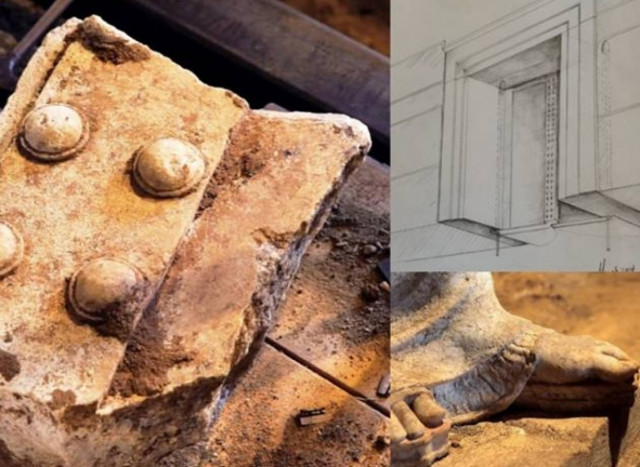Amphipolis: What's behind the marble gate of the third chamber?
The excavations in the funerary monument in Kasta hill of Amphipolis are in progress and the agony is peaking.

The hoe of Katerina Peristeri brought to the "light" significant new findings that enhance the view that this is a Macedonian tomb. It was revealed part of a marble double door and a staircase or ramp that seems to lead in a fourth chamber in the heart of the monument, at a depth of two meters.
Once removed the soil from the third chamber, the archaeologists saw a door of Thassos marble with studs that mimic the nail head. They also found a hinge. This fact leads archaeologists to believe that this is a form of Macedonian tomb.
Behind the elaborate marble double door, there is the third chamber of the burial monument, with a maximum height of almost 8.5 meters, and its floor is about two meters down.
Archaeologists speculate that disasters in marble door came either from bombing of the area by the Bulgarians in 1913 or from the earthquake of 6.8 on the Richter scale that occurred in the 6th AD century or from earthquakes of the 19th century.
As noted, the door may be broke the later years of construction, due to the earthquake that occurred in the region or other natural phenomena (floods, etc.).
"We cannot know if there was an attempt of tomb looting, only excavation will show us this," said the head of the archaeologists, Katerina Peristeri.
Regarding the "occupant" or "occupants" of the burial monument, Mrs. Peristeri replied that "it is too early to say. If an excavation has not been finished, archaeologists can never tell who or what is inside."
Referring to the support works, Mrs. Peristeri noted that they are progressing very well and that these works must be done for the safety of workers and the safety of the monument.
The archaeologists also found iron and copper nails, however, it is not assumed to belong to the stretcher of the dead.
The significance of these findings is large, as in this way proves that this is a standard form of a Macedonian tomb.
Strong indications that the tomb in Amphipolis has been looted
The Ministry of Culture admits now in the most formal way, that the tomb in Amphipolis is highly likely to have been looted.
Both the head of the excavations, Katerina Peristeri, and the general secretary of the Ministry of Culture, Lina Mendoni appreciated that the evidence shows that robbers have entered the tomb.
In particular, Katerina Peristeri expressed the opinion that it is likely in ancient times robbers to tried to go inside the tomb, but it would have been difficult to get through, while Mrs. Mendoni added: "The grave robbing was common practice in ancient times. We have strong evidence that in ancient times there were attempts of looting. We cannot know until where they managed to go."
The communications Officer about the tomb, Anna Panagiotarea analyzes why is the caryatids are Greek
According to Mrs. Panagiotarea, the text which has posted belongs to Professor Paul N.. Efthymiou. In this text is explained the anatomy of the feet of the Caryatids of Amphipolis (the second finger longer than the first), which in medicine is called Morton's toe, and in sculpture is called "Greek foot".
It is a situation in which the second toe is longer than the first. There are three types of normal feet. The Egyptian Foot, in which from the big toe to the smallest there is a diagonal line with the big toe longer than the rest, the Roman Foot or square, where all the fingers are in a horizontal line and the Greek Foot as was described before. The large (70-80%) majority of the world's population has the Egyptian foot, as is the "normal" in osteology, ie what "should" have each person based on the bone structure of our species. There's a whole movement in medical communities worldwide to abolish the term "Egyptian" as is the typical scientifically sound.
But there is no question about the term "Greek", only its implied replacement with the term "Morton's toe" and its characterization as a bone deformity.
But what is the difference with the other species other than the size of the metatarsal bone? The Greek Foot is hereditary!
The incredible thing is that the "deformity" of "Greek Foot" gene is associated with Greeks.
That means that anyone who has a larger second finger on his feet has necessarily Greek genes?
The answer is YES!!!
And this is probably the element that they are trying to "forget", turning this feature on genetic bone deformity.
In sculpture, there is countless evidence of knowledge of the existence of this attribute to the Greeks of ancient times. ALL the statues of ancient Greek figures which illustrate Greeks are bearing this characteristic. It is no coincidence that our ancestors included the feet in their works. They knew their difference and they depicted it.
























